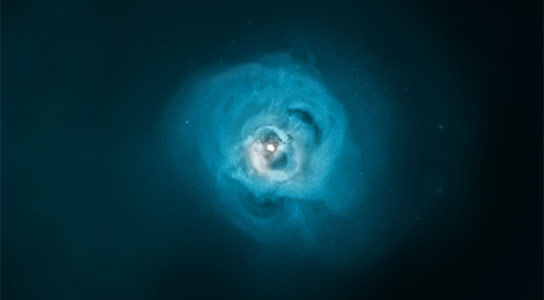
An X-ray image of the hot gas in the central region of the Perseus Cluster of galaxies, taken by the Chandra X-ray Observatory. The Perseus Cluster is one of the most massive objects in the Universe with thousands of galaxies immersed in an enormous cloud of superheated gas. The image shows enormous bright loops, ripples, and jet-like streaks throughout the cluster. Astronomers may have detected an emission line from a form of dark matter, the sterile neutrino, in the spectrum of galaxy clusters like Perseus. Credit: Chandra/NASA/ESA
Using data from the Chandra X-ray Observatory, astrophysicists may have detected an emission line from a form of dark matter, the sterile neutrino, in the spectrum of galaxy clusters.
Galaxies are often found in groups or clusters, the largest known aggregations of matter and dark matter. The Milky Way, for example, is a member of the “Local Group” of about three dozen galaxies, including the Andromeda Galaxy located about 2 million light-years away. Very large clusters can contain thousands of galaxies, all bound together by gravity. The closest large cluster of galaxies to us, the Virgo Cluster with about 2000 members, is about 50 million light-years away.
The space between galaxies is not empty. It is filled with hot intergalactic gas whose temperature is of order ten million kelvin, or even higher. The gas is enriched with heavy elements that escape from the galaxies and accumulate in the intracluster medium over billions of years of galactic and stellar evolution. These intracluster gas elements can be detected from their emission lines in X-ray, and include oxygen, neon, magnesium, silicon, sulfur, argon, calcium, iron, nickel, and even chromium and manganese.
The relative abundances of these elements contain valuable information on the rate of supernovae in the different types of galaxies in the clusters since supernovae make and/or disburse them into the gas. Therefore it came as something of a surprise when CfA astronomers and their colleagues discovered a faint line corresponding to no known element. Esra Bulbul, Adam Foster, Randall Smith, Scott Randall, and their team were studying the averaged X-ray spectrum of a set of seventy-three clusters (including Virgo) looking for emission lines too faint to be seen in any single one when they uncovered a line with no known match in a particular spectral interval not expected to have any features.
The scientists propose a tantalizing suggestion: the line is the result of the decay of a putative, long-sought-after dark matter particle, the so-called sterile neutrino. It had been suggested that the hot X-ray emitting gas in a galaxy cluster might be a good place to look for dark matter signatures, and if the sterile neutrino result is confirmed it would mark a breakthrough in dark matter research (it is of course possible that it is a statistical or other error). Recent unpublished results from another group tend to support the detection of this feature; the team suggests that observations with the planned Japanese Astro-H X-ray mission in 2015 will be critical to confirm and resolve the nature of this line.
Reference: “Detection of an Unidentified Emission Line in the Stacked X-Ray Spectrum of Galaxy Clusters” by Esra Bulbul, Maxim Markevitch, Adam Foster, Randall K. Smith, Michael Loewenstein and Scott W. Randall, 10 June 2014, The Astrophysical Journal.
DOI: 10.1088/0004-637X/789/1/13
arXiv: 1402.2301









Neutrino is the signature of all the matter in this Universe, because there is a continuous outpour of neutrinos in the decay of proton to neutron and vice versa and also in the quarks. We find three distinct types of neutrinos in nature namely, electron neutrino, muon neutrino and tau neutrino with three different flavors. Moreover, these neutrinos change their flavors in their transit in the cosmos. Extending the same argument, neutrinos could be the signature of the invisible but yet dominant Dark Matter also. The Dark Matter neutrinos could be of different flavors of their ensemble.Dark Matter also should decay and produce neutrinos of their kind. This article gives a clear grip to the signature of the Dark Matter, truly, if confirmed beyond doubt. Thank You.
“Dark matter” continues to be a mathematical and mythical concoction used to “make the equations balance”. No proof yet exists other than the current models don’t match reality without a very large correction factor of something that “we can’t detect but must be there because the equations don’t work unless we add it in.” Uhuh, sure. Maybe, just maybe, the equations are wrong and all the “gravitational effects” being attributed to undetectable “dark matter” are really “electromagnetic effects” from a very much known force – the highly energetic ions between the galaxies. These “ten million kelvin” hot particles can also be sources of E-M fields that cause attractive effects, i.e. “Electric Universe” as proposed by Halton Arp as long ago as the ’70s.
Hello! Electron,or Electric Universe cannot wield gravitational effect on matter, or rather they can only be attracted by Matter or Dark MATTER only or can get deflected. It is only the MATTER that wields gravity. Moreover, electric field is the offspring of a matter only. A field like electric field can interact with another field only existing in matter like Raman Effect. No doubt that intergalactic space is replete with ions and electrons , but that does not mean that they effect gravity on galaxies. It is true that galaxies expand and propelling force should be another matter which we call as DARK MATTER. Just because, we have not found the texture of Dark Matter, it cannot be simply dispensed with. Gravitation alone cannot account for crumbling of galaxies into several galactic groups like our Local Group. Some other central force is needed that is huge enough to keep our Milky Way Galaxy to go in spirals and keeps the stars at a distance in several arms.Thank You.